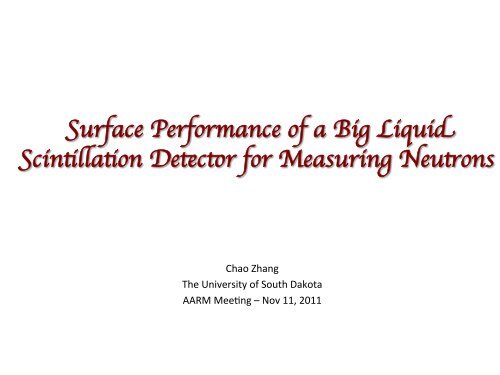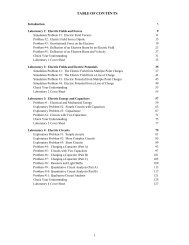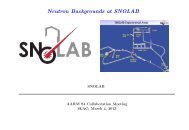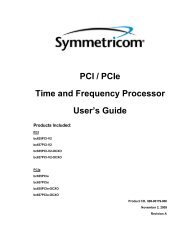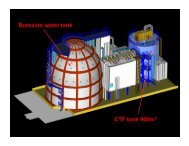Surface Performance of a Big Liquid Scintillation Detector for ...
Surface Performance of a Big Liquid Scintillation Detector for ...
Surface Performance of a Big Liquid Scintillation Detector for ...
You also want an ePaper? Increase the reach of your titles
YUMPU automatically turns print PDFs into web optimized ePapers that Google loves.
<strong>Surface</strong> <strong>Per<strong>for</strong>mance</strong> <strong>of</strong> a <strong>Big</strong> <strong>Liquid</strong><br />
<strong>Scintillation</strong> <strong>Detector</strong> <strong>for</strong> Measuring Neutrons <br />
Chao Zhang <br />
The University <strong>of</strong> South Dakota <br />
AARM Mee:ng – Nov 11, 2011
The role <strong>of</strong> neutrons in underground <br />
low background experiments <br />
Fatal background <br />
– behave the same way as signals <br />
– Cosmogenic produc:on caused radioac:vi:es <br />
² Two categories <br />
ü radioac:ve ac:va:on <br />
-‐ (a, n), fission decay <br />
ü spalla:on & capture <br />
neutrons <br />
Related to the local rock <br />
composi:on, radioac:vity, <br />
and the geometries – a library is <br />
need to understand its intensity. <br />
2
Large <strong>Liquid</strong> Scin:lla:on Neutron <strong>Detector</strong> <br />
<strong>Big</strong> Neutron <strong>Detector</strong><br />
Design<br />
A 10L liquid scintillation counter has been<br />
built and tested in the lab.<br />
it's a 5'' in diameter, 1 meter in length<br />
Aluminum tube filled with EJ-305 liquid<br />
scintillators. EJ-520 reflective paint is<br />
uni<strong>for</strong>mly painted on the inner surface <strong>of</strong> the<br />
tube.<br />
ü 1m long LS neutron detector filled<br />
with 12 liters LS EJ301.<br />
ü Internally covered with diffusive<br />
paint EJ520 and purged with<br />
Argon gas.<br />
ü 2 Hamamtsu 5” PMTs(R4144)<br />
attached to the detector through<br />
Pyrex glass windows.<br />
Two PMTs (R4144 , hamamatsu) installed<br />
at the both ends <strong>of</strong> the counter.
<strong>Detector</strong> Response <br />
• Working High Voltage: Ch0 2000V, Ch1 2000V, aWenuator 23dB applied <strong>for</strong> Both. <br />
• Time coincidence within 30ns(peak :me) are required <strong>for</strong> two PMTs. <strong>Detector</strong> <br />
response to the room background signal are shown above(Ch0 le[, Ch1 right). <br />
• Muon minimum ioniza:on peak and the response to 22Na source along with the Tube <br />
are marked in the le[ figure. We can use these curves <strong>for</strong> energy reconstruc:on. <br />
4
Calibra:on <br />
AmBe <br />
Na22 <br />
0 <br />
Na22: 1.0μCi. Placed at each 2.5 cm along with the tube. <br />
AmBe: 3.33MBq. Placed at the fixed posi:on above the detector. <br />
5
Response to 22Na source <br />
• Actual posi:on VS charge ra:o response to 22Na source(Le[). <br />
• Total charge (Ch0) VS charge ra:o response to 22Na source(Right) <br />
6
AmBe Source <br />
• AmBe: about 68.3 hours data(le[) and the one with background subtracted(right) <br />
• The AmBe source(3.33MBq) is placed at 6.5cm above the detector, close to Ch0 end <br />
about 15cm and to Ch1 end about 60cm. <br />
7
Energy Reconstruc:on <br />
• AmBe neutrons with cut area0>2500 (Le[). Red curve indicates 11 MeV real energy. <br />
• Energy spectrum comparison between the simulated AmBe neutron by assuming <br />
100% detec:on efficiency and the reconstructed neutron data (Right). <br />
• Quenching factor is applied to convert visible energy to recoil energy. <br />
8
Detec:on Efficiency <br />
9
Room Background Data <br />
• Room Background about 19 days data. <br />
10
Room Neutron Spectrum <br />
11
Comparison with Others <br />
M.S. Gordon et. al, IEEE, Vol.51, No.6, P3427 <br />
• On the ro<strong>of</strong> <strong>of</strong> a building, NY. <br />
§ In the first floor <strong>of</strong> PaWerson Hall, USD <br />
12
Soudan Data <br />
13
Soudan Data <br />
Soudan mine 65.2 days data <br />
14
Current Status <br />
• <strong>Detector</strong> is working stable at 2000V high voltage with <br />
good n/g PSD. <br />
• Muon minimum ioniza:on peak is present with 23dB <br />
signal aWenua:on applied to both PMTs. Together with <br />
22Na source, posi:on and energy rela:ons are well <br />
understood. <br />
• By using AmBe source, the detec:on efficiency <strong>for</strong> <br />
neutrons with energy below 11MeV is calibrated. <br />
• About three weeks surface room background data <br />
were accumulated. The detector has been running at <br />
Soudan mine <strong>for</strong> a few months. <br />
15
PMT R4144 <br />
Spectral Response <br />
Backup I: Op:cal proper:es <br />
Figure 4:<br />
CATHODE RADIANT SENSITIVITY (mA/W)<br />
QUANTUM EFFICIENCY (%)<br />
Typical Spectral Response <strong>of</strong> Head-On, Bialkali<br />
Photocathode<br />
100<br />
10<br />
1<br />
0.1<br />
0.01<br />
200<br />
CATHODE<br />
RADIANT<br />
SENSITIVITY<br />
QUANTUM EFFICIENCY<br />
400 600 800<br />
WAVELENGTH (nm)<br />
TPMOB0070EA<br />
PHOTOCATHODE MATERIALS<br />
The photocathode is a photoemissive surface usually consisting<br />
<strong>of</strong> alkali metals with very low work functions. The photocathode<br />
materials most commonly used in photomultiplier tubes<br />
are as follows:<br />
1) Ag-O-Cs<br />
The transmission-mode photocathode using this material<br />
is designated S-1 and sensitive from the visible to infrared<br />
range (300 to 1200nm). EJ 320 Since Ag-O-Cs has comparatively<br />
high thermionic dark emission Paint (refer to "ANODE DARK CUR-<br />
RENT" on page 8), tubes <strong>of</strong> this photocathode are mainly<br />
used <strong>for</strong> detection in the near infrared region with the photocathode<br />
cooled.<br />
6) High temperature bialkali or low noise bialkali<br />
(Na-K-Sb)<br />
This is particularly useful at higher operating temperatures<br />
since it can withstand up to 175°C. A major application<br />
is in the oil well logging industry. At room temperatures, this<br />
photocathode operates with very EJ 301 low dark current, making it<br />
ideal <strong>for</strong> use in photon counting Scin:llator applications. <br />
7) Multialkali (Na-K-Sb-Cs)<br />
The multialkali photocathode has a high, wide spectral response<br />
from the ultraviolet to near infrared region. It is widely<br />
used <strong>for</strong> broad-band spectrophotometers. The long wavelength<br />
response can be extended out to 930nm by special<br />
photocathode processing.<br />
8) Cs-Te, Cs-I<br />
These materials are sensitive to vacuum UV and UV rays<br />
but not to visible light and are there<strong>for</strong>e called solar blind. Cs-<br />
Te is quite insensitive to wavelengths longer than 320nm,<br />
and Cs-I to those longer than 200nm.<br />
WINDOW<br />
Pyrex<br />
MATERIALS<br />
<br />
The window materials commonly used in photomultiplier<br />
tubes are as follows:<br />
1) Borosilicate glass<br />
This is frequently used glass material. It transmits radiation<br />
from the near infrared to approximately 300nm. It is not<br />
suitable <strong>for</strong> detection in the ultraviolet region. For some applications,<br />
the combination <strong>of</strong> a bialkali photocathode and a<br />
low-noise borosilicate glass (so called K-free glass) is used.<br />
The K-free glass contains very low potassium (K2O) which<br />
can cause background counts by 40 K. In particular, tubes designed<br />
<strong>for</strong> scintillation counting <strong>of</strong>ten employ K-free glass not<br />
only <strong>for</strong> the faceplate but also <strong>for</strong> the side bulb to minimize<br />
noise pulses.<br />
16 <br />
16 <br />
2) UV-transmitting glass (UV glass)
Key Specifications<br />
Backup II: R4144 PMT & EJ301 <br />
Related Produc<br />
lator)<br />
Part Number<br />
Type<br />
Size<br />
ActiveDia/L<br />
Min<br />
R4144<br />
Head on<br />
127mm<br />
120mm<br />
300!m<br />
Q.E. ~ 20% <br />
L. Y. ~ 12000pe/MeV <br />
Socket Bar<br />
E678-20B<br />
Max<br />
650!m<br />
Peak Sens. 420!m<br />
Cathode Radiant Sensitivity<br />
72mA/W<br />
Window<br />
Borosilicate<br />
Cathode Type<br />
Bialkali<br />
Cathode Luminous Sensitivity<br />
70!A/lm<br />
Cathode Blue Sensitivity Index 9<br />
Anode Luminous Sensitivity<br />
100A/lm<br />
Gain<br />
1.4E+06<br />
Dark Current after 30 min.<br />
10nA<br />
ENI 10<br />
Rise Time<br />
1.5ns<br />
Transit Time<br />
35ns<br />
Transit Time Spread<br />
0.7ns<br />
Number <strong>of</strong> Dynodes 8<br />
Applied Voltage<br />
3000V<br />
Multi Anode<br />
N<br />
Socket Bare<br />
E678-20B<br />
17
Backup III: Quenching factor <br />
E_visible=E_real*0.5806*(1-‐exp(-‐0.2072*E_real-‐0.00335)) <br />
18


